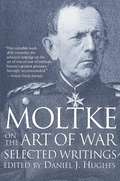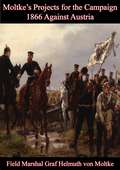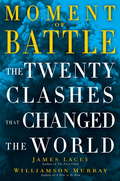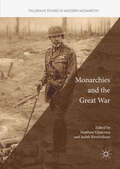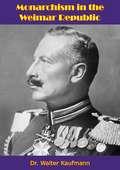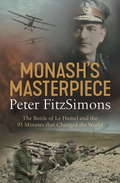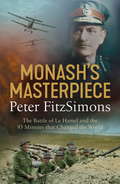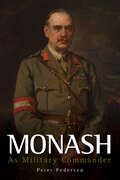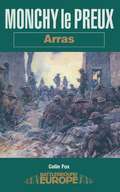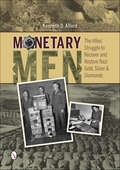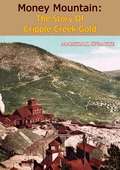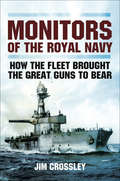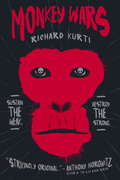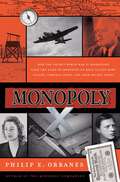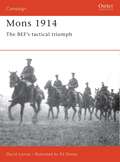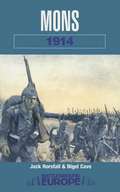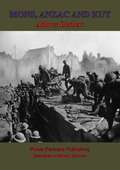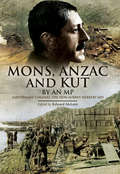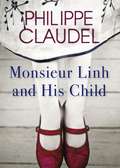- Table View
- List View
Moltke on the Art of War: Selected Writings
by Daniel HughesPrussian hero Field Marshal Helmuth Graf von Moltke was the architect of the German way of war.
Moltke: Sketched in Journals, Letters, Memoirs, A Novel, and Autobiographical Notes
by Field Marshal Graf Helmuth von MoltkeOriginally published in 1892, this is a memoir of German Field Marshal Helmuth Graf von Moltke (the Elder), chief of staff of the Prussian Army for 30 years, compiled from numerous personal journals, letters, and notes. It also draws on his father’s memoirs and one of Moltke’s tales, “The Two Friends.”Richly illustrated throughout with drawings by Moltke, portraits and facsimile letters.“THE nature of the subject of this volume rendered it impossible that the contents should appear as if cast in one mould. This circumstance might be regarded as a defect, but its justification will be found partly in the many-sided character of a long and eventful life, which showed a rich development and a mature perfection of every human faculty, and partly in the fact that for some periods of this life original authorities were lacking. The volume is therefore intended, as was inevitable, to produce its effect by the impression it makes as a whole. Our knowledge of the Field-Marshal must be supplemented from notes regarding his family and his own life, from journals of travels, and records of the many impulses, scientific and artistic, to which his travels gave rise; further, from an attempt in the region of Belles Lettres—the novel of “The Two Friends,” in which he, the man of eight-and-twenty, paints himself true to the life; finally, from the vigorous productions of his old age, with their strivings after the highest truth, which, under the title of “Consolatory Thoughts,” form the conclusion of the volume.”- Editor’s Note
Moltke’s Projects for the Campaign of 1866 Against Austria
by Field Marshal Graf Helmuth von MoltkeOriginally published in 1907, this is the translation by the British Army War Office of Field Marshal Moltke’s military papers relating to the war of 1866 (first published in their original German in 1896).“A NEW light was thrown upon the campaign of 1864 by the publication, in 1892, of Moltke’s military correspondence during that war—a volume which revealed, as nothing published before it had done, the brilliant abilities and resolute character of the Prussian general. That delightful volume was followed, in 1896, by the publication of a selection from Moltke’s military papers relating to the war of 1866...They are divided into four parts, collected under the headings of preparation, mobilization, and deployment, the actual operations, the truce and peace. The chief interest of these disclosures lies in the first part, for it is the arrangements for the first deployment and subsequent concentration of the Prussian Army that have formed the principal subject of controversy in regard to this campaign. Moreover, since the construction of railways, the great importance which always in every campaign has attached to the opening has been, if anything, increased. The opening is usually arranged with a deliberation impossible in the subsequent stages of the action. It is the part of the game which admits of the completest study beforehand, and it is the part in which for this campaign abundant evidence is now given. Moltke’s colleagues of the Staff have told us since his death that they were much impressed by his habitual effort to think things out, and that he used in this process to assist himself by putting his thoughts on paper and rewriting his analysis or his argument again and again until he found it satisfactory.”
Moment of Battle
by Williamson Murray Jim LaceyTwo modern masters of military history make their case for the twenty most pivotal battles of all time, in a riveting trip through the ages to those moments when the fate of the world hung in the balance. In the grand tradition of Edward Creasy's classic Fifteen Decisive Battles of the World, James Lacey and Williamson Murray spotlight only those engagements that changed the course of civilization. In gripping narrative accounts they bring these conflicts and eras to vivid life, detailing the cultural imperatives that led inexorably to the battlefield, the experiences of the common soldiers who fought and died, and the legendary commanders and statesmen who matched wits, will, and nerve for the highest possible stakes. From the great clashes of antiquity to the high-tech wars of the twenty-first century, here are the stories of the twenty most consequential battles ever fought, including * Marathon, where Greece's "greatest generation" repelled Persian forces three times their numbers--and saved Western civilization in its infancy * Adrianople, the death blow to a disintegrating Roman Empire * Trafalgar, the epic naval victory that cemented a century of British supremacy over the globe * Saratoga, the first truly American victory, won by united colonial militias, which ensured the ultimate triumph of the Revolution * Midway, the ferocious World War II sea battle that broke the back of the Japanese navy * Dien Bien Phu, the climactic confrontation between French imperial troops and Viet Minh rebels that led to American intervention in Vietnam and marked the rise of a new era of insurgent warfare * Operation Peach, the perilous 2003 mission to secure a vital bridge over the Euphrates River that would open the way to Baghdad Historians and armchair generals will argue forever about which battles have had the most direct impact on history. But there can be no doubt that these twenty are among those that set mankind on new trajectories. Each of these epochal campaigns is examined in its full historical, strategic, and tactical context--complete with edge-of-your-seat you-are-there battle re-creations. With an eye for the small detail as well as the bigger picture, Lacey and Murray identify the elements that bind these battles together: the key decisions, critical mistakes, and moments of crisis on which the fates of entire civilizations depended. Some battles merely leave a field littered with the bodies of the fallen. Others transform the map of the entire world. Moment of Battle is history written with the immediacy of today's news, a magisterial tour d'horizon that refreshes our understanding of those essential turning points where the future was decided. Advance praise for Moment of Battle "A riveting human story about how a few remarkable individuals changed 2,500 years of history."--Victor Davis Hanson, author of Carnage and Culture and The Savior Generals"Two world-class historians present, eloquently and persuasively, twenty battles that fundamentally changed the course of history. Moment of Battle is a must acquisition for anyone seeking to understand the nature of human development--and its turning points."--Dennis E. Showalter, professor of history, Colorado College, author of Armor and BloodFrom the Hardcover edition.
Monarchies and the Great War (Palgrave Studies in Modern Monarchy)
by Matthew Glencross Judith RowbothamThis volume challenges the traditional view that the First World War represents a pivotal turning point in the long history of monarchy, suggesting the picture is significantly more complex. Using a comparative approach, it explores the diverse roles played by monarchs during the Great War, and how these met the expectations of the monarchic institution in different states at a time of such crisis. Its contributors not only explore less familiar narratives, including the experiences of monarchs in Belgium and Italy, as well as the Austro-Hungarian, Japanese and Ottoman Empires, but also cast fresh light on more familiar accounts. In doing so, this book moves away from the conventional view that monarchy showed itself irrelevant in the Great War, by drawing on new approaches to diplomatic and international history - ones informed by cultural contextualization for instance - while grounding the research behind each chapter in a wide range of contemporary sources The chapters provide an innovative revisiting of the actual role of monarchy at this crucial period in European (indeed, global) history, and are framed by a substantial introductory chapter where the key factors explaining the survival or collapse of dynasties, and of the individuals occupying these thrones, are considered in a wide-ranging set of reflections that highlight the extent of common experiences as well as the differences.
Monarchism in the Weimar Republic
by Dr Walter Kaufmann“The present essay is a pragmatic study of monarchism as a political factor in Germany during the period of the Weimar Republic. It seeks to illuminate the history of that period by concentrating on the most powerful opposing force with which the democratic republic in Germany was confronted during the major part of its existence. It also aims at an answer to the question why the fall of the Weimar Republic did not bring about a restoration of the monarchy but, on the contrary, destroyed monarchism together with democracy.“In tracing monarchism during the Weimar Republic, we shall distinguish two main periods. During the first, until 1923, monarchism was the core of a violent rightist opposition to the republican form of government. During the second, from 1923 to 1933, monarchism adopted a more moderate policy. It became an oppositional movement in the republican state in whose government it participated at various times, while it gradually became outflanked by a non-monarchistic rightist movement—National Socialism.”
Monash's Masterpiece: The battle of Le Hamel and the 93 minutes that changed the world
by Peter FitzSimonsThe Battle of Le Hamel on 4 July 1918 was an Allied triumph, and strategically very important in the closing stages of WWI. A largely Australian force, commanded by the brilliant Sir John Monash, fought what has been described as the first modern battle - where infantry, tanks, artillery and planes operated together as a coordinated force.Monash planned every detail meticulously, with nothing left to chance. Integrated use of tanks, planes, infantry, wireless (and even carrier pigeons!) was the basis, and it went on from there, down to the details: everyone used the same maps, with updated versions delivered by motorbike despatch riders to senior commanders, including Monash. Each infantry battalion was allocated to a tank group, and they advanced together. Supplies and ammunition were dropped as needed from planes. The losses were relatively few. In the words of Monash: 'A perfected modern battle plan is like nothing so much as a score for an orchestral composition, where the various arms and units are the instruments, and the tasks they perform are their respective musical phrases.'Monash planned for the battle to last for 90 minutes - in the end it went for 93. What happened in those minutes changed for the rest of the war the way the British fought battles, and the tactics and strategies used by the Allies.Peter FitzSimons brings this Allied triumph to life, and tells this magnificent story as it should be told.
Monash's Masterpiece: The battle of Le Hamel and the 93 minutes that changed the world
by Peter FitzSimonsThe Battle of Le Hamel on 4 July 1918 was an Allied triumph, and strategically very important in the closing stages of WW1. A largely Australian force commanded by the brilliant John Monash, fought what has described as the first modern battle - where infantry, tanks, artillery and planes operated together, as a coordinated force.Monash planned every detail meticulously - with nothing left to chance: integrated use of planes, wireless (and even carrier pigeons!)was the basis, and it went on from there, down to the details.Infantry, artillery, tanks and planes worked together of the battlefront, with relatively few losses. In the words of Monash: 'A perfect modern battle plan is like nothing so much as a score for an orchestral composition, where the various arms and units are the instruments, and the tasks they perform are their respective musical phrases.'
Monash: As Military Commander
by Dr. Peter PedersenDr Peter Pedersen&’s scholarly study of Sir John Monash remains the finest analysis of Australia&’s best known military leader. In 1918 the Australian Corps under Monash&’s command played a leading role in the Allied advance to victory on the Western Front. Its successes in the battles of Hamel and Amiens, the taking of Mont St Quentin and Péronne and the breaching of the Hindenburg Line are among the most prominent landmarks in Australia&’s military history. Monash was central to these pivotal achievements. This book traces Monash&’s development as a commander from his pre-war militia service to his wartime experience at Gallipoli and on the Western Front. It examines in detail how each stage of his military career influenced his approach to command and the tactical problems he faced as the wartime commander of an infantry brigade and division and, ultimately, the Australian Corps. The influence of his education and civilian training are also examined in this meticulous study. What emerges from this nuanced and sophisticated assessment of Monash as a soldier is a superb portrayal of how a commander works and what he could achieve under conditions so inimical to the exercise of command as those that prevailed on the Western Front. Along the way, Dr Pedersen establishes Monash&’s place among his contemporaries, British and Australian, and provides the definitive answer to the question &‘Just how good was Monash?&’ Published for the centenary of the great victories of 1918, this new and updated edition of Dr Pedersen&’s classic work is a timely study of Australia&’s finest general.
Monchy le Preux: Arras (Battleground Europe)
by Colin FoxAs the motorist speeds past Arras on the motorway south to Paris, a look to the east should bring into view the hilltop village of Monchy le Preux. This farming community dominates the ground to the North (as it falls away to the River Scarpe) and to the South ( to the River Coejeul). In the early days of the Battle of Arras in the spring of 1917 the Village fell to British attacks after a stubborn resistance by the German defenders.Therefore the struggle continued to wage just to its east as all attempts to move the line significantly further into the German defences failed. In 1918 the German spring offensive rapidly regained lost ground, but stumbled and faltered on the outskirts of Arras. When it came to the British turn to launch what was to turn put to be the final offensive of the war in this sector; it was the Canadian forces that led the way here. Monchy and the countryside round about has returned, for the most part, to a tranquil, rural spot. Few of the topographical features that loomed so important in 1917 and 1918 have disappeared, so that this is a battlefield where it is easy to follow the action, whilst walking along its tracks shows how significant a vantage point this was to the combatants of 1917 and 1918.There are a few remnants of the war, and mementoes continue to give stark reminders of the bitter struggles of eighty years and more ago. In the spring of 1998 over twenty British soldiers whose bodies had been unexpectedly unearthed in the course of land development were buried in Monchy British cemetery
Monetarism, Economic Crisis and the Third World
by Karel JansenFirst Published in 1983. Routledge is an imprint of Taylor & Francis, an informa company.
Monetary Men: The Allies’ Struggle to Recover and Restore Nazi Gold, Silver, and Diamonds
by Kenneth D. AlfordA complete accountability of the financial treasures looted by the Nazis
Money Mountain: The Story of Cripple Creek Gold
by Marshall SpragueCripple Creek was the last of the open gold camps before mining fell to giant corporations. Its life was short and violent, but towns, cities, schools, railroads, institutions and financial dynasties grew upon its yield. Today a million tourists each year pour through the region, enjoying what Teddy Roosevelt called "the ride that bankrupts the English language" through Cripple's upper reaches, and imagining the gaudy, brawling days when the quiet, patched and peeling facades of the town were new.Those are the days that Marshall Sprague, New York Times correspondent, calls back to life in this fascinating book.He says of his book: "When I moved to Colorado Springs, and began hearing about Cripple, I wanted some information. None existed in one place, so I dug up the story. I spent a year at it. I combed the libraries, news files, directories, court records and cemeteries. Most important, I interviewed dozens of Cripple Creek pioneers. I hope this adds freshness to a story which should have been written a long time ago."
Monitoring Metabolic Status: Predicting Decrements in Physiological and Cognitive Performance
by Institute of Medicine of the National AcademiesThe U.S. military's concerns about the individual combat service member's ability to avoid performance degradation, in conjunction with the need to maintain both mental and physical capabilities in highly stressful situations, have led to and interest in developing methods by which commanders can monitor the status of the combat service members in the field. This report examines appropriate biological markers, monitoring technologies currently available and in need of development, and appropriate algorithms to interpret the data obtained in order to provide information for command decisions relative to the physiological readiness of each combat service member. More specifically, this report also provides responses to questions posed by the military relative to monitoring the metabolic regulation during prolonged, exhaustive efforts, where nutrition/hydration and repair mechanisms may be mismatched to intakes and rest, or where specific metabolic derangements are present.
Monitors of the Royal Navy: How the Fleet Brought the Big Guns to Bear
by Jim CrossleyMonitor warships mounted the biggest guns ever deployed by the Royal Navy, and played an undeniably important part in Allied efforts during World War One and Two. They were built as cheap "disposable" ships made out of redundant bits and pieces which the Admiralty happened to have available which could bring heavy artillery to bear on enemy coasts with pin point accuracy and on at least one occasion a force of only three monitors had a profound effect on the strategic situation in WW I. Being classed as disposable they were often exposed to risks far more recklessly than more expensive battle ships or heavy cruisers. So impressive was their performance in WW I that two were retained in service into WW II and did such good work during the North African campaign that two new ones were built and they fought in the Mediterranean, in the Normandy landings and in the advance of the Allied armies into occupied Europe. They astonished allies and enemies alike with the devastating effect of their accurate fire reaching targets 10 miles or more inland.The book deals with the origins of Monitors and how they evolved from the bomb ketches of the 18th century. It looks at how the various classes of monitor were designed and built and explores their careers in both World Wars, including the particular impact they had on the various campaigns in which they fought. It attempts to assess their effectiveness as compared to some other classes of ship, and is sure to appeal to a wide range of related enthusiasts.
Monkey Fun! (Xist Children's Books)
by Julia DweckMonkey Fun! proves that you’re never too young to begin your learning adventure. It’s a barrel of fun and chock full of interesting monkey facts written in easy to understand rhyming verse for toddlers ages 0-4. “That’s not a monkey who’s peeling a grape. Bigger and tailless, he must be an ape.” “Monkeys who live in a family group, travel together and share with their troop.” Bold, colorful illustrations by Aida Barba Flores will capture the attention of young readers and aid in story comprehension. This is an edutaining rhyming adventure that offers fun learning resources in the back of the book including, Mrs. Dweck’s monkey facts and a monkey counting game.
Monkey Wars
by Richard Kurti"Strikingly original" is how Anthony Horowitz, author of the Alex Rider series, describes Monkey Wars. "Kurti draws from history to deliver a powerful allegory . . . [and] keeps this effective, memorable tale rooted in reality." --Publishers Weekly, Starred Review Sustain the weak. Destroy the strong. A dark fable in the vein of Animal Farm, Watership Down, and The Wave, this action-packed page-turner is told entirely from the monkeys' points of view and shines a light on the politics of power, the rise of tyrants, and the personal dilemmas that must be faced when your life is on the line. When rhesus monkeys are brutally massacred on the dusty streets of Kolkata by a troop of power-hungry langur monkeys, Mico, a privileged langur, becomes entangled in the secrets at the heart of his troop's leadership and is shocked at what he discovers. He feels compelled to help the few surviving rhesus, especially Papina, a young female he befriends, even though doing so goes against everything he's been taught. As more blood is spilled, Mico realizes that choosing between right and wrong won't be easy. Includes a note from the author, as well as interesting monkey species facts. Additional praise for MONKEY WARS "The allure of power--even for the most conscientious--is portrayed with frightening effectiveness. Powerful."--Kirkus Reviews "An imaginative fable about the nature of power and the responsibility of the individual. With plenty of action . . . a fascinating epilogue . . . [and] striking cover art." --Booklist "Following in the tradition of George Orwell's Animal Farm and William Golding's Lord of the Flies, war and politics shape the lives of several monkey troops. An interesting premise that will provide readers with an introduction to fascism and political corruption." --School Library JournalFrom the Hardcover edition.
Monongahela 1754#55
by Stephen Walsh Rene ChartrandOn 9 July 1755 amid the wilderness of North America, Britain suffered one of the most humiliating defeats in her history. General Braddock's army, a mixture of British regulars and American militia, was shattered, losing over 900 men from a force of 1,300. Braddock was killed and the remnants of his army rescued by his aide, Colonel George Washington. The origins of this defeat can be traced back to the death of a junior French officer little more than a year before in a relatively minor skirmish with a party of Virginian militia commanded by the same George Washington. René Chartrand examines the subsequent chain of events that ultimately sparked a world war.
Monopoly X: How Top-Secret World War II Operations Used the Game of Monopoly to Help Allied POWs Escape, Conceal Spies, and Send Secret Codes
by Philip E. OrbanesAn amazing true story of World War II that reveals how British and American military intelligence successfully smuggled escape aids into German P.O.W. camps hidden inside Monopoly game boards, and also the game’s surprising role in espionage.Monopoly X is the fascinating true story of what is arguably the most unusual and best-kept secret operation of World War II. The masterminds at England’s top-secret MI-9, and later America’s MIS-X, created a special version of the popular game, hiding tools, maps, and money within game boards—delivered by fictitious charities—to captured Allied servicemen held at gunpoint behind barbed wire in German prison camps. This ingenious and complex plot, dubbed “Monopoly X,” was never discovered by the Nazis and led to many successful Allied breakouts.The creation and consequences of Monopoly X remained a deep secret through the war and for decades after, until now. For the first time, Phillip E. Orbanes tells the full story of the people behind this clandestine program—how it was devised, implemented, and used to great success. A tale of derring-do as compelling as the World War II classic, The Great Escape, Monopoly X is an amazing war story of Allied intelligence services, resistance forces in Europe, heroes and heroines, a notorious traitor, and the pivotal role a seemingly innocent board game played in secret codes and espionage.Monopoly X includes a 16-page black-and-white photo insert.
Mons 1914
by Ed Dovey David LomasOsprey's examination of the Battle of Mons of World War I (1914-1918). When the First World War broke out in August 1914 the Imperial German Army mistakenly assumed that the BEF - 'that contemptible little army' - would be easily defeated. They were stopped in their tracks by the numerically inferior British force, whose excellent marksmanship cost the closed packed German ranks dear. Eventually forced to fall back by overwhelming German numbers, the British carried out a masterful fighting retreat across Belgium and northern France. At Mons, nine and a half British battalions held four German divisions at bay for an entire day. This book examines not just the battle of Mons itself but also the ensuing British retreat including the actions at Le Cateau and Villers-Cotterêts.
Mons 1914: Mons 1914 (Battleground Europe)
by Nigel Cave Jack HorsfallThe Great War opened with a major reversal for the BEF followed by a daring and epic withdrawal. This book describes these dramatic events.
Mons, Anzac and Kut: A British Intelligence Officer In Three Theatres Of The First World War, 1914-18
by Aubrey HerbertA brilliant British memoir from three different theatres of the First World War; widely regarded as one of the finest written during the early period after the war. Despite being badly short-sighted, the author wished to serve his country with a passion and started off his military carrier as an interpreter. However, it wasn't long before he found himself in the thick of the fighting in 1914. At the forefront, in the confused fighting around Mons as the British turned at bay, he was wounded and captured. In a throwback to earlier days of chivalry, he was exchanged for a German prisoner of equal rank and standing.Out of the frying pan and into the fire of Gallipoli, Herbert writes passionately of the experiences and suffering of his fellow Allied soldiers, but he is characteristically self-depreciating of his own heroic conduct under the shellfire. After the end of the campaign in the Dardanelles, the author was posted out to Mesopotamia as an intelligence officer, ending his military career."Fascinating, straightforward, and very well written, best on Mons and Gallipoli." - p. 120, Edward Lengel, World War I Memories, 2004, The Scarecrow Press, Lanham Maryland, Toronto, Oxford. Author - Herbert, Aubrey, 1880-1923.Text taken, whole and complete, from the edition published in London, E. Arnold, 1919.Original Page Count - 251 pages.Illustrations -- 4 maps.
Mons, Anzac and Kut: By an MP (Lieutenant Colonel The Hon Aubrey Herbert MP)
by Edward MelotteAubrey Herbert was one of the most interesting figures of his age. He was twice offered the Albanian throne! Born almost blind, his sight even after surgery precluded him from official military service and he became a diplomat and politician. However in 1914 he attached himself unofficially to the Irish Guards on the outbreak of war on their way to France and was made an honorary Lieutenant. Despite his service overseas in France, the Dardanelles and then Egypt and Iraq, he remained an MP throughout the War. He was briefly captured in the Retreat from Mons and, after recovering from his wounds, he joined the Intelligence Bureau in Egypt before being attached to the New Zealand and Australian Division at Gallipoli. He personally persuaded General Ian Hamilton, the overall Commander, to agree a temporary truce with the Turks to enable the burial of the dead and the recovery of wounded men in no-mans-land. Later in Iraq, his efforts to buy the release of the beleaguered British garrison at Kut were less successful. His extraordinary war experiences brought him into close contact with a wide cast of characters, not least T E Lawrence, Compton McKenzie and leading military and political figures.
Monsieur Linh and His Child
by Philippe ClaudelTraumatized by memories of his war-ravaged country, his son and daughter-in-law dead, Monsieur Linh travels to a foreign land to bring the child in his arms to safety. To begin with, he is too afraid to leave the refugee centre, but the first time he braves the freezing cold to walk the streets of this strange, fast-moving town, he encounters Monsieur Bark, a widower whose dignified sorrow mirrors his own. Though they have no shared language, an instinctive friendship is forged; but Monsieur Linh's stay in the dormitory is only temporary. Sooner or later he and his child must find a permanent home.Delicate and restrained, but with an extraordinary twist, Monsieur Linh and His Child is an immensely moving novel of perfect simplicity, by the author of Brodeck's Report.
Monsieur Linh and His Child
by Philippe ClaudelTraumatized by memories of his war-ravaged country, his son and daughter-in-law dead, Monsieur Linh travels to a foreign land to bring the child in his arms to safety. To begin with, he is too afraid to leave the refugee centre, but the first time he braves the freezing cold to walk the streets of this strange, fast-moving town, he encounters Monsieur Bark, a widower whose dignified sorrow mirrors his own. Though they have no shared language, an instinctive friendship is forged; but Monsieur Linh's stay in the dormitory is only temporary. Sooner or later he and his child must find a permanent home.Delicate and restrained, but with an extraordinary twist, Monsieur Linh and His Child is an immensely moving novel of perfect simplicity, by the author of Brodeck's Report.
